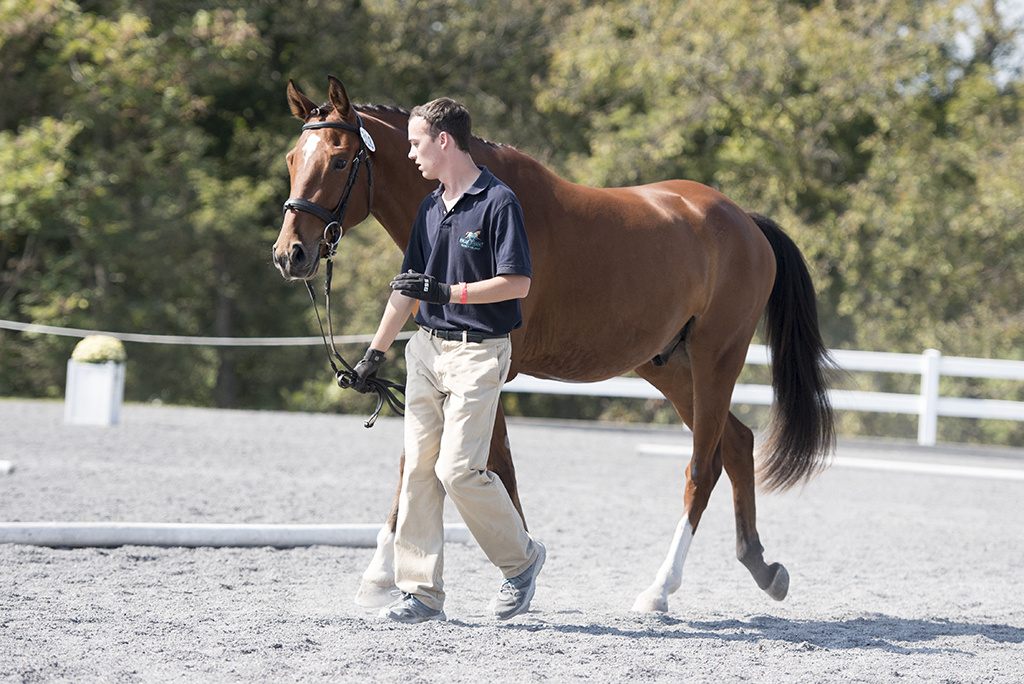The Importance of the Walk in the Future Event Horse Program with Klaus Schengber

The Young and Future Event Horse article series is being provided through a partnership between Mythic Landing Enterprises, LLC., and the USEA.
Klaus Schengber has been one of the most sought after handlers in the Future Event Horse Program since its birth. After handling and showing young horses in Germany as a young adult, Schengber traveled to New York in 1986 and began working for Thornbrook Farm, home of the first horse embryo transfer. Schengber now bases himself out of High Point Hanoverians located in Chesterfield, Maryland where he specializes in starting young horses for a sporthorse career. He often hosts young horse training clinics, and can be found handling multiple horses in USEA Future Event Horse (FEH) competitions, as well as various breed shows across the country.
As an owner of a young horse, it can be tempting to want to show them off yourself at these competitions, but having a professional handler guide them through their first couple shows can be very beneficial. Schengber explains, “As a professional, I feel less attached to the horses I’m showing, we’re here to do a job and show your horse off to the best of its ability.” He continues, explaining that any horse is going to act differently at a show than it does at home and the owner may have different expectations, which can throw them off if the horse isn’t performing to plan. As a professional handler, Schengber may not know a horse at all before showing up at the show so he is able to react to the situation as it happens without any prior expectations.
Schengber believes that the walk is the most important gait that you present in FEH competitions because the judges do not get to see the horse canter. Schengber explains, “You can improve a horse’s trot, but there is not much you can do to improve their walk. A big walk indicates a big canter with a big stride, a quality that makes up a potentially successful upper-level eventer. A big walk will always win the class rather than a big trot.”

USEA/Leslie Mintz Photo.
Schengber continues to explain that in order to achieve a big walk the horse must be relaxed first and foremost. This calmness translates directly from the handler. So when getting ready to go in the ring with a horse, he suggests thinking about something else so that you don’t get anxious. Your goal is for your horse to pick up on your calmness, and walk in the ring as if he’s walking out to the pasture.
To achieve this walk, Schengber cues his horse by dropping the rein down just a bit so it’s next to the horse’s shoulder. You want to imagine how you hold a lead rope when you’re taking them out to the field, which easily allows the horse to move forward.
Schengber adds that he does very minimal trotting in-hand at home or in warmup at the shows. He shares, “Once the horse understands the cue to the trot at home, I’ll practice it once or twice during a session, but that’s it.” When it comes to the warm-up at the shows, he suggests remaining at the walk since trotting them in the warm-up in a show environment can get them charged up and then when they head into the ring they are anticipating the trot and then your walk is gone.
Keeping it simple and continually instilling confidence in these young horses is key. Schengber concludes, “In a lot of these young horses the biggest training hurdle I come across is a lack of confidence. Work on something small everyday and build on it. Repeat that skill if you have to, keep it calm and easy to they are able to understand and are able to build on their skills everyday.”
Klaus Schengber will be available for a jump chute and handling clinic at Loch Moy Farm on Oct. 5, 2016. This is a great opportunity to prepare for the FEH Championships on the following day (Oct. 6). Click here for more information.
To learn more about Klauss Schenbgber and his program please visit his website: http://www.hphanoverians.com/














